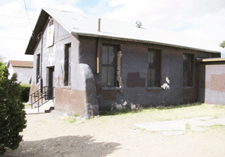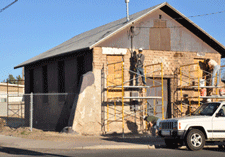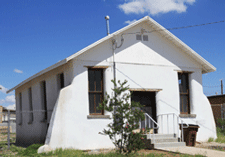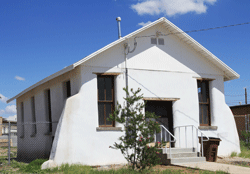 |
Phillips Chapel in the Mesquite Historic District
History of Phillips Chapel Daniel Hibler purchased the land on which Phillips Chapel CME Church was built for $45.00 and had it deeded to the Colored Methodist Episcopal Church in America on May 1, 1911. The chapel was named after the Right Reverend Charles H. Phillips, the first presiding bishop of the Colored Methodist Episcopal Church in America. Phillips Chapel is the oldest African-American church in Las Cruces. Throughout its long history Phillips Chapel has served the Las Cruces community as a civic and social center. Clarence Fielder, grandson of Daniel and Ollie Hibler remembers attending many social activities held at the chapel when he was a child, and speaks fondly of “youth groups, ice cream socials, and hobo parties where we’d go house to house dressed as hobos and come back to have picnics with the food and goods we collected”. Many African-American couples were married in the chapel, and their children christened there. After Booker T. Washington School was built Phillips Chapel continued to serve as a place where baccalaureate services were held when African-American students graduated from the segregated Booker until integration occurred in 1954 following the Supreme Court ruling of Brown v. Topeka Board of Education. The chapel was listed on the State Register of Cultural Properties and National Register of Historic Places in 2003 thanks to the hard work of Terry Moody and Clarence Fielder. The restoration of Phillips Chapel began in 2010 and has been a three year labor of love by many concerned volunteers and students of Doña Ana Community College. Story and photos courtesy: Faith Hutson |
 Phillips Chapel Before Restoration |
 Phillips Chapel During Restoration |
 Phillips Chapel Today |
About Las Cruces | Privacy Policy | Site Usage Agreement | Contact Us | Advertise With Us
© Copyright 2025 MeetLasCruces.com - All Rights Reserved Worldwide.
 In the early 1900’s African-Americans began settling in Las Cruces, NM where they began new lives in numerous venues. Members of the Colored Methodist Episcopal Church first worshipped in the home of Daniel and Ollie Hibler. When the congregation grew too large they rented a small frame building at the corner of Campo Street and East Court Avenue. Services were held there until Phillips Chapel was completed in 1911.
In the early 1900’s African-Americans began settling in Las Cruces, NM where they began new lives in numerous venues. Members of the Colored Methodist Episcopal Church first worshipped in the home of Daniel and Ollie Hibler. When the congregation grew too large they rented a small frame building at the corner of Campo Street and East Court Avenue. Services were held there until Phillips Chapel was completed in 1911.